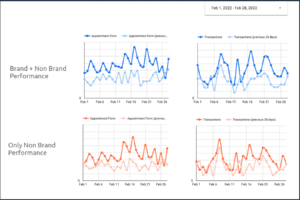
Challenges:
- The limited budget and high targets were a challenge at the point of realizing the KPIs.
- We planned and implemented the project during the low seasonal period of the brand. Our goal was to improve account performance when seasonal volume rose.
- Conversion goals that differed by category resulted in splitting the budget and delayed learning time.


The Approach:
- Pmax Campaign Optimization: We divided the Pmax campaign, which works as an all-product, into 2 Evening Dresses and Wedding Dresses, within the framework of the website categories. While we aimed to increase the sales in the evening dress campaign, we aimed to increase the appointment forms in the wedding dress campaign.
- Search Generic Goal-Based Keyword Strategy: Multiple campaign structures and insufficient budgets were restricting campaign learning. For this reason, we implemented the focusing strategy on budgets to accelerate the learning process. We grouped the existing keywords in the account into two campaigns “awareness and conversion”. While grouping, the keyword attribute was taken as a basis. According to a high-quality score, keywords were added to campaigns at the ad group level. The click target for the awareness campaign and the ROAS target for the conversion campaign was defined.
- Shopping Golden Strategy: The category-based shopping campaign structure was established.


Hard work always pays
Results:
- When we evaluated the overall advertising performance, we were able to increase the transaction and appointment forms by over 100%, increasing the budget by 30%.
- When we examined the performance of the non-brand campaigns, we increased the costs of the non-brand campaigns by only 45%, on the other hand, we managed to increase the appointment forms and transactions by 5x.
- We increased the non-brand campaign share in advertising revenue from 8% to 50%. 🎉

Increased Revenue
142%

Increased the appointment forms
115%

Increased Transaction
191%

Share of non-branded campaign sales increased from 8% to
50%



















